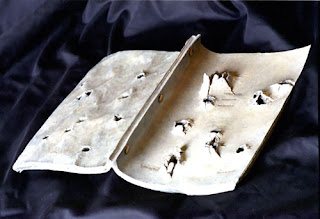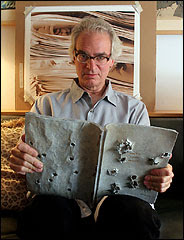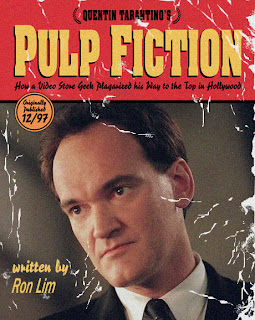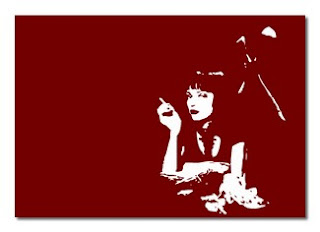Write the Shots!

Hey guys,
Despite everything, I managed to finish an article I had been working on for some time - because Mystery Man is a MACHINE! Hehehe…
Okay, let’s just clear the air of so much bad thinking about action lines. I don’t know how or why this happened, but a lot of newbies seem to think that a scene is comprised of 1) a Master Scene Heading (such as INT. MYSTERY MAN’S KITCHEN – NIGHT) and 2) they should just add some action lines to describe the room, the characters, write a bunch of dialogue, (and quite a few more action lines to describe even the slightest gestures of characters, which we call incidental actions), and 3) move on to the next scene and repeat this process for 120 pages.
Wrong.
How did they get so far away from the core principles of screenwriting? Were they mislead? I don’t know. Even by the very low standards described above, some newbies can’t even get that right and they fill their action lines with what we call unfilmmables – sentences in action lines that are not visual, such as backstories of characters, author’s intrusions, inner thoughts, questions to the reader, etc.
Now, what do we know about action lines? With Trottier’s Screenwriter's Bible, we know that we ARE meant to describe the setting, characters, or actions of those characters, but these sentences must be very lean and mean. We write only what we see on the screen and only the most essential elements using the most minimal words. We have to provide a framework of visuals that tell the story so the reader (and audience) can put two & two together and visualize what's happening on the screen. Action paragraphs should be 4 lines or fewer. You typically write one paragraph per beat of action, and they should be important actions. I loved what Trottier said about incidental actions: “If your character raises her cup of coffee to her lips, that’s not important enough to describe… unless there’s poison in the cup.”
Hehehe...
Always, always err on the side of brevity.
Now let’s take it to the next level. The only way you can truly excel at writing cinematic stories (on a par with or surpassing the pros) is to elevate your craft to a level where you can (without using camera angles) WRITE THE SHOTS.
Bwaaah! You’re SO wrong, Mystery Man! Yes, I can hear you balking already and screaming at your monitors that, dammit, man, you can’t describe the shots because it’s up to the director to decide how that scene will be filmed and thus, all you can do is just tell the story – what happens to what character and then move on to the next scene.
Wrong.
That’s completely and absurdly wrong.

This kind of hands-off thinking about filmmaking has harmed more screenplays, prevented more writers from getting sales, and generally lowered the quality of contemporary films. It’s not enough that we, as screenwriters, must have a god-like knowledge about the story we wrote and about the art of storytelling, characters, dialogue, and structure. Screenwriters are filmmakers, too, and we have to think like filmmakers and endeavor to render our stories CINEMATICALLY, which means that we should write the shots.
This does not, has not, and will not ever offend directors or anyone else. On the contrary, reading a truly visual, cinematic screenplay that really feels like a movie on paper INSPIRES readers, INSPIRES producers, INSPIRES executives, and yes, directors, too, and those are the scripts that GET SALES. I mean, come on. The way to get a director onboard is to get him/her excited about the story and the visuals. And your screenplay is essentially the first grouping of cinematic ideas, the first shot across the bow about how to render this particular story cinematically. It’s the springboard for what will be many future creative discussions about turning your script into a film.
Conflicts between screenwriters and directors have more to do with a screenwriter not thinking like a filmmaker (and wanting to tell instead of show) than it is about a director not recognizing how brilliant the dialogue is. Rules about not writing the shots so as to avoid offending directors are so absurd, because, like everything else in life, this business is about relationships. It's ALL about the relationships you build with people in the business. Period. If you walk into a room and say “this is the way it is and to hell with what you think - no one big or small can change one word or comma of my screenplay,” yeah, everyone will hate you. If, on the other hand, you walk into a room and you're capable of having a creative discourse and engaging people who have different ideas and calmly explaining how and why and what you were trying to accomplish with each moment of your screenplay, you’ll go far. Establishing good, working, creative relationships with people is, umm, a good thing for your career.
With some directors, that’s impossible, but that’s another article.
So let’s talk about writing the shots. I once had a brief conversation about this topic in e-mail with Jennifer van Sijll, a screenwriting professor, consultant, former professional reader for Universal, and author of Cinematic Storytelling. She wrote,
“I think a writer should avoid anything that takes readers out of the read. As soon as they start visualizing equipment rather than what's on the screen, they've broken from the story. Here is an example.
Joe scans the room. His eyes land on the glock. He stops. He trains his eye on the murder weapon, and puts a match to the curtains.
This is a pan, probably a push in to closeup, and a wideshot.
If you can write without mentioning camera angles, it's more engaging.”
Exactly. She also wrote a great article about this called Directing-the-Director. Here’s a portion in which she discusses a scene from Pulp Fiction. (People always remember Pulp Fiction for it’s great structure and dialogue, but many don’t realize that he also wrote the shots and practically edited each scene through the action lines.)

Cinematic Example: Editing - Pacing and Expanding Time
In the drug overdose scene, midpoint in the movie, Vincent (John Travolta) attempts to revive Mia (Uma Thurman) by stabbing Mia’s heart with a hypodermic needle filled with adrenalin. The scripted scene fills us with tension. We hold our breath hoping that Mia is going to make it.
The reason “we hold our breath” is because the script is written “already edited.” In this case it is edited to “milk the scene” and thereby pump up suspense.
So how does Tarantino do this?
Tarantino does this through overlapping action. He includes cuts to the needle, the red dot, and the faces of characters. These cuts lengthen the time needed for the real-time-event of the stabbing to occur. Although Vincent counts out three seconds on the dialogue track, it takes ¾ of a page for the moment to take place or 45 seconds of screen time. That means that we are holding our breath 15 times longer than Vincent’s three-second countdown suggests.
Through purposeful use of editing, the writer is guiding the reader’s emotional experience, and delivering a scene that can be imagined as a movie.
Writing in Shots
Tarantino accomplishes this by writing in shots. He doesn’t write in descriptive paragraphs like novelists. Each of his sentences implies a specific camera angle. “Implies” is the operative word here. Camera angles and lenses are not called out, but understood from his description.
The script’s pacing mimics what we will later see on screen. Paragraphing and sentence length suggest how long a shot will play on the screen. For example, a single one-sentence paragraph implies one shot. The implication is that it should play out longer on screen than would say, multiple shots implied in a four-line paragraph. The white space buys the single shot time. Adding an editorial aside like “Mia is fading fast. Nothing can save her now” is like saying “hold on the shot”. It again gains the shot more screen time.

Let’s take a look at how this is done in the actual script. This excerpt is taken from mid-scene.
The top line is from Tarantino’s script, where no camera information is given. The parentheticals in the line below are my interpretation of the shot that is implied.
Excerpt from Pulp Fiction
Vincent lifts the needle up above his head in a stabbing motion. He looks down on Mia.
(LOOSE CLOSE-UP VINCENT) (VINCENT POV – MIA)
Mia is fading fast. Soon nothing will help her.
(HOLD ON MIA.)
Vincent’s eyes narrow, ready to do this.
(TIGHT CLOSE-UP – VINCENT)
VINCENT
Count to three.
Count to three.
Lance on his knees right beside Vincent, does not know what to expect.
(WIDE SHOT – LANCE AND VINCENT)
LANCE
One.
One.
RED DOT on Mia’s body.
(CLOSE ON RED DOT )
Needle poised ready to strike.
(CLOSE ON NEEDLE)
LANCE
Two.
Two.
Jody’s face is alive in anticipation.
(CLOSE-UP JODY)
NEEDLE in the air, poised like a rattler ready to strike.
(CLOSE ON NEEDLE)
LANCE (OS)
Three!
Three!
The needle leaves the frame, THRUSTING down hard.
(CLOSE ON NEEDLE)
Vincent brings the needle down hard, STABBING Mia in the chest.
(MEDIUM SHOT)
Mia’s head is JOLTED from the impact.
(CLOSE ON MIA’S HEAD)
The syringe plunger is pushed down, PUMPING the adrenalin out through the needle.
(CLOSE ON SYRINGE PUMPER)
Mia’s eyes POP WIDE OPEN and lets out a HELLISH cry of the banshee.
(CLOSE-UP ON MIA’S EYES)
She BOLTS UP in a sitting position, needle stuck in her chest---SCREAMING
(WIDE SHOT - MIA)
Summary
In this brief page, Tarantino has implied 15 camera angles. Despite his use of camera, the reader isn’t taken out of the read because the script never calls out specific camera positions or angles.
Had Tarantino described the camera angles with 15 descriptors like CLOSE-UP ON MIA’S EYES, it would have been an unbearable read.
Tarantino was able to slow down real time by cutting away to objects and multiple reaction shots of the characters. He used editing and the inherent elasticity of the medium to help dramatize a pivotal moment and up the suspense.
Pacing was further aided by how Tarantino suggested shot length through paragraphing.
I also want to share one more quote from Jennifer’s article:
“Writing cinematically is not the same as Directing-the-Director. Directing-the-director is when you write: “JOE’S POV WINDOW– LOW ANGLE,” instead of “Joe looks up at the window.” They mean the same thing. The first unnecessarily draws attention to camera information taking us completely out of the story. The second method implies it’s a POV shot and a low-angle, but it does not distract us with technical jargon. Similarly if a tracking shot is essential to a scene it’s better to say “Joe jogs alongside Susan” rather than “TRACKING SHOT – JOE AND SUSAN JOGGING which is considered directing-the-director.”
Exactly. I couldn’t agree more.
Consider the “write the shots” example I gave in my Billy Mernit script review. Remember how visual that was? Consider how Melissa Mathison brilliantly incorporated low angles from the creature’s POV in the opening sequence of her E.T. screenplay to make the trucks, the lights, and the keys, all so very scary and to establish the humans as the antagonistic force. Consider the L.A. Riverbed sequence in Chinatown where Gittes follows Mulwray. With Secondary Headings, Robert Towne starts with long shots, then cuts back and forth between Gittes and Mulwray. When the action gets intense, he goes to close-ups of Gittes. Consider the way Apocalypse Now and Barton Fink uses creative camera angles to disorient the audience in order to make a statement about the mental state of the protagonist. You can write that so long as you don't use camera angles. I could go on and on.
Did you know that the world’s first screenplay was written by a woman? Yes, Alice Guy-Blaché wrote “screen-plays” in order to organize her thoughts and all the ways she would experiment with sound and visual effects in the late 1800s. The whole point of her “screen-plays” was to write the shots. By the way, the first screenplay was for a short called The Cabbage Fairy/La Fée aux choux (France, 1896), which was a comic fantasy about babies that were born in cabbage patches. Guy-Blaché would go on to direct over 700 short films and establish one of the world’s first movie studios – Solax.
I don’t mean to say that you have to edit every scene and write every shot with every action line. Sometimes, you just need to write about the action, and yes, the director will figure out how to film it. But write the shots when it really counts. And now you can also take a deep breath and embrace and study all those old screenplays that are full of camera angles. The only thing that’s changed is the fact that we no longer write camera angles, but the principles of action lines have never changed in that we should think like filmmakers, we should render our stories cinematically, and we should write the shots.
-MM






















14 comments:
Great post MM.
hall of fame entry, man...
I wrote this scene with Jennifer's book in mind -
INT. CELLAR - NIGHT
It’s black.
Sounds of stilettos on a concrete floor.
A yellowed florescent light sputters to life.
Jack struggles against the chains that have him pinned to the wall.
The black leather hood lies next to a rubber mallet on a nearby rickety old table. A piece of duct tape covers his mouth.
LACY (O.S.)
How’s it feel, asswipe?
Lacy, clad in the same scanty ensemble as earlier, approaches Jack.
In one hand, a
BIG FUCKIN’ KNIFE, dripping with blood.
In the other, a Dove ice cream bar.
Jack, eyes wide, stares at the knife in horror.
LACY
Recognize this? One of your favorites, I believe.
She slices the buttons from his shirt with the tip of the very sharp blade as Jack, petrified, watches the last one fall in slow motion.
She spreads his shirt open with the knife tip to reveal the location where most of the hair from his head has migrated.
She gives him the once-over.
LACY
You’re such a liar. Furry AND flabby. Yuck.
She tickles the tip of one of his nipples with the sharp edge of the knife. He flinches and issues a muffled cry as the blade scrapes the sensitive flesh.
Lacy giggles, teases the Dove bar with her tongue and jerks the knife upward with a quick flick of her wrist. Behind the gag, Jack screams.
LACY
I’d say payback’s a bitch but I think you used that one. In Gruesome Twosome, I think. Or was it Hammered? I forget. They all just kind of melt into one.
She sets the ice cream bar on the table (where it sizzles like a steak on a grill), grabs a handful of chest hair and, wielding the knife like a straight razor, dry-shaves the patch. Jack’s cries become louder and more high-pitched.
Jack watches with fear as a
FEMALE HAND
retrieves the mallet from the table. His fear becomes terror when he follows the hand up the
ARM
Across the
SHOULDER AND NECK
to
KITTY’S FACE.
She stares at Jack, licks the back of her free hand and, in a sweeping motion, wipes it across her forehead and back across her hair.
I love you. This is a great example of how to engage your reader. I used to write (or try to write) in such a manner, using CAPS, too, but it was beaten out of me at Triggerstreet to a small degree. I may have to re-think some decisions I've made about my writing over the past 18 months.
Rock on, MM!
What a great way to begin the week -- energized. Thanks Mr. Man.
Amen, Amen, I say to you Amen, Allelujia. Great article, MM, and I thank you for the super example from pulp fiction of "how to do it" without those pesky camera directions!
Tarantino did use the phrase "out of frame" at one point, but other than that, yes, good example of how to write the shots without directing the camera.
(I know. I'm so picky)
I like how you emphasized that our job (among others) is to INSPIRE the director and crew with our words. I'm always telling people this on the boards and in my reviews.
Great post, MM. I think of something similar but I call it "directing the eye."
It's good for multiple shots in a room. Sometimes, I'll use sec. headings for this also to denote "close-shots" not close-ups but only the heading in the frame.
I'm also thinking about trying a short with no dialogue. I just have to figure the best way to trigger emotional outbursts which will correspond to body language.
Wait, how about this.
Jack strides angrily into the room. In his hand a slightly crumpled sheet of paper.
He forces it at the young girl seated on the couch at the far side of the room.
She takes it from him timidly. Her head goes down to read it.
Jack taps his foot impatiently.
The young girl raises her head. A tear trails down her cheek.
Jack snatches the paper back and points to a door in the hallway.
The girl gets up. She begins to walk. Jack clears his throat.
She turns and grabs a bag off of the couch and ambles dejectedly towards the door in the hallway.
Jack plops down on the couch and grabs the remote. Evening News stories fill the room as he changes channels.
That's a good exercise. Can anyone figure out what happened? I guess that's the test.
"Vincent lifts the needle up above his head in a stabbing motion. He looks down on Mia.
(LOOSE CLOSE-UP VINCENT) (VINCENT POV – MIA)"
Just wanted to point out that this is NOT a Vincent POV shot. It's a shot of Vincent (facing us) looking down at Mia.
It's also not really a close up.
Most likely it will be a MEDIUM SHOT to encapsulate the action of Vincent raising the needle above his head.
I completely agree with the gist of your post. I just think that whole section on disecting PULP FICTION shot for shot is overly complicated.
My point -- Hmm -- I have one somewhere --
Oh... I think too much emphasis on "editing" the visuals with such a high degree of exactness can hinder the read of the story.
Large sections of KILL BILL have this problem.
You can get the reader to a point where they are saying to themselves, "Yeah, I get it. It's going to be a big melee fracas. Move on with the story already."
The scene you chose form PULP FICTION is a good one. I'm just saying, all things in balance.
MM,
Outstanding post! This is why I highly recommend anyone with screenwriting software to configure the SHOT element so that it has the same formatting as the SCENE HEADING and then use the SHOT as a secondary heading.
Most readers I've talked to love secondary headings and after a while it's almost as if they absorb the heading instead of actually reading it -- kind of a peripheral vision thing.
Again, great post.
Unk
Excellent post, MM.
I will simply say - I agree
Dix, Todd - Thanks so much, guys.
Pat - Ya know, I read that somewhere before and loved. I still love it. That's exactly what I'm talking about. Good job.
Carl - So great to hear from you! This is such a great, important topic. I think we've undervalued for too long how important this really is. At least, I think so.
Nena - Hehehe...
Bob - Thanks, man. I knew you'd understand.
Mim - You're right as always. I noticed that, too, and thought, "pfft, amateur." Hehehe...
Christian - I like it! Your feedback is forthcoming, too. This damn strike's put me behind.
James - I agree, particularly with all things in balance. I don't believe we should be that exacting either with respect to editing, but at the same, when it's a big, pivotal scene in your script, I say devote to this kind of detail in your action lines to make it really stand out, ya know? And readers who have studied screenwriting and have gone through hundreds of scripts will notice that you're writing the shots, and more often than not, it'll impress them.
Unk - I think we should - SHHH - keep this a secret and not talk about this with the community so we can have an advantage. Hehehe... Hope you're doing well, my friend.
Tim, Cross - Thanks so much.
-MM
Sohbete inananların bulustugu yere gitmek için burayıSohbet odalarıTurkiyede Chat'in gercek adresine gitmek için burayıChatistanbullularla sohbet etmek için ise burayıistanbul sohbetEger aşkla ilgili bişilere bakacaksanız burayı tıklamanız yeterli olacaktır.Mynet Sohbet thanks you very much.
Post a Comment